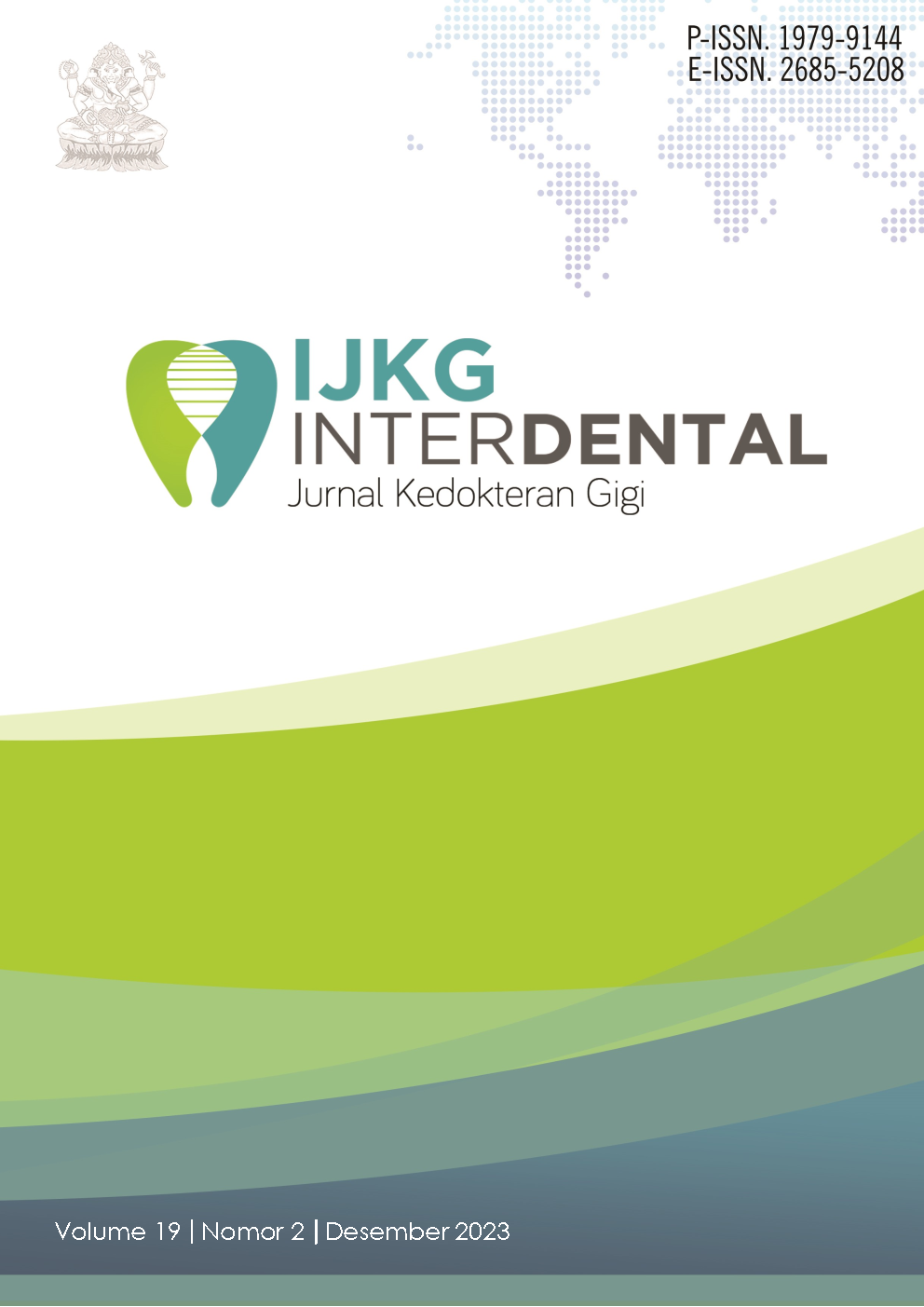SPACE SEARCH FOR MINOR CROWDING CASES WITH EXPANSION PLATE IN PATIENTS WITH A HISTORY OF ANTIDEPRESSANT DRUG CONSUMPTION
DOI:
https://doi.org/10.46862/interdental.v19i2.6667Keywords:
antidepressant, expansion plate, removable orthodontic applianceAbstract
Introduction: Gaining space in malocclusion cases using expansion plate removable orthodontic appliances. Depression is a mental health disorder that is treated with antidepressants. There is a correlation between a history of long-term antidepressant medication use and orthodontic treatment.
Case: A 21-year-old female patient with a history of antidepressant medication complained of slightly advanced maxillary front teeth and crowded mandibular front teeth. Clinical examination revealed the first permanent molar relation Angle Class I modified Dewey type 2 malocclusion with malposition of individual teeth. Arch discrepancy analysis showed a space deficiency of 4 mm in the maxilla and 2.85 mm in the mandible.
Case Management: The first stage used a removable orthodontic appliance for maxillary and mandibular expansion plates to obtain space deficiency. The expansion results showed that the maxillary dental arch was successfully expanded by 4.52 mm and the mandibular by 4 mm.
Discussion: The slow-type expansion plate functions to expand the dental arch.
Conclusion and Suggestion: Expansion plate removable orthodontic treatment effectively gains space in patients with a history of antidepressant drug use. Patients' cooperativeness in wearing the appliance influences the expansion plate removable orthodontic appliance treatment result.
Downloads
References
Venkateshwaran K, Kaur S, Shaon. Slow maxillary expansion: A review. Int. J. Health Sci. 31 Desember 2021;303–14.
Venkata T, Mahendra D, Anoosha M. Mandibular Expansion Appliances and Their Activation Protocols Mandibular Expansion Appliances and Their Activation Protocols. 2022;34(3). https://doi.org/10.38209/2708-2636.1135
Quinzi V, Caruso S, Mummolo S, Nota A, Angelone AM, Mattei A, dkk. Evaluation of Lower Dental Arch Crowding and Dimension after Treatment with Lip Bumper versus Schwarz Appliance. A Prospective Pilot Study. Dentistry Journal. 10 April 2020;8(2):34.
Vania E, Zenab Y, Sunaryo IR. Laporan penelitian Kemajuan perawatan ortodontik dengan sekrup ekspansi rahang atas pada crowding ringan. J Kedokt Gigi. 2016;28(2):113–8. DOI 10.24198/jkg.v30i2.19796
Noviasari P, Karunia D, Dirdjowihardjo S. Keberhasilan perawatan ortodonti lepasan dengan ekspansi dan pencabutan gigi incisisivus. Clin Dent J. 2020;6(2):2–7.
Singh H, Kapoor P, Sharma P, Maurya RK, Mittal T, Bhagat DK. Treatment of a Severe Tooth Size-arch Length Discrepancy Using Rapid Maxillary Expansion and Mandibular Incisor Extraction: An Unconventional Combination Approach. J Indian Orthod Soc. Januari 2019;53(1):69–76.
Antoszewska-Smith J, Bohater M, Kawala M, Sarul M, Rzepecka-Skupień M. Treatment of Adults with Anterior Mandibular Teeth Crowding: Reliability of Little’s Irregularity Index. International Journal of Dentistry. 2017;1–6.
Paryontri BA, Burhani CMD. Case Report: Scissor Bite Correction with Removable Expansion Plate. Dalam: Permana I, Rochmawati E, editor. Proceedings of the International Conference on Sustainable Innovation on Health Sciences and Nursing (ICOSI-HSN 2022) [Internet]. Dordrecht: Atlantis Press International BV; 2022 [dikutip 20 April 2023]. hlm. 294–301. Tersedia pada: https://www.atlantis-press.com/doi/10.2991/978-94-6463-070-1_35
Pawinru AS, Dewang D. Some appropriate anchorages for removable orthodontics appliance. MDJ. 25 Juli 2020;9(2):148–55.
Rousstia EL, Farmasyanti CA, Kuswahyuning. Pertimbangan penggunaan plat ekspansi pada perawatan ortodontik cekat kasus borderline. MKGK. April 2016;2(1):53–8.
Phulari BS. Orthodontics: Principles and Practice. JP Medical LTD. 2011;322.
Christensen JR, Fields H, Sheats RD. Treatment Planning and Management of Orthodontic Problems. Pediatric Dentistry (Sixth Edition), Elsevier. 2019;512-53.e3.
Patel M, Daruwala N. Appraisal of dental arch dimension in Gujarati males and females. Adv Hum Biol. September 2015;5(3):61–7.
Konstantonis D, Anthopoulou C, Makou M. Extraction decision and identification of treatment predictors in Class I malocclusions. Prog Orthod. Desember 2013;14(1):47.
Mohammad Z, Cheruku SR, Penmetcha S, Namineni S, Vaaka PH. Customized Modified Haas Palatal Expansion in Mixed Dentition: A Case Report. Journal of Clinical and Diagnostic Research: JCDR. 2016 Oct;10(10):ZD01. https://doi.org/10.7860/JCDR/2016/20394.8655
Asiry MA. Biological aspects of orthodontic tooth movement: A review of literature. Saudi Journal of Biological Sciences. September 2018;25(6):1027–32.
Dhenain T, Côté F, Coman T. Serotonin and orthodontic tooth movement. Biochimie. Juni 2019;161:73–9.
Hashmi AM, Han JY, French-Rosas L, Jabbar Q, Khan BA, Shah AA. Benzodiazepine Use and Abuse. Psychiatric Annals. Agustus 2018;48(8):360–5.
Krishnan V, Zahrowski JJ, Davidovitch Z. The Effect of Drugs, Hormones, and Diet on Orthodontic Tooth Movement. Dalam: Krishnan V, Kuijpers‐Jagtman AM, Davidovitch Z, editor. Biological Mechanisms of Tooth Movement [Internet]. 1 ed. Wiley; 2021 [dikutip 20 April 2023]. hlm. 199–215. Tersedia pada: https://onlinelibrary.wiley.com/doi/10.1002/9781119608912.ch14
Downloads
Published
How to Cite
Issue
Section
License
Copyright (c) 2023 Puspitarini Nindya Wardana, Yely Okta Mariza

This work is licensed under a Creative Commons Attribution-ShareAlike 4.0 International License.
- Every manuscript submitted to must observe the policy and terms set by the Interdental Jurnal Kedokteran Gigi (IJKG)
- Publication rights to manuscript content published by the Interdental Jurnal Kedokteran Gigi (IJKG) is owned by the journal with the consent and approval of the author(s) concerned.
- Full texts of electronically published manuscripts can be accessed free of charge and used according to the license shown below.













